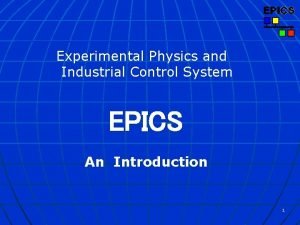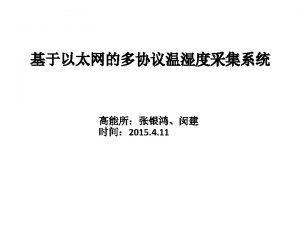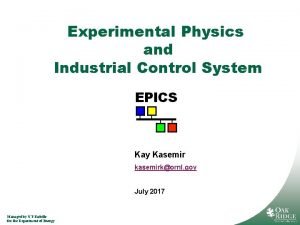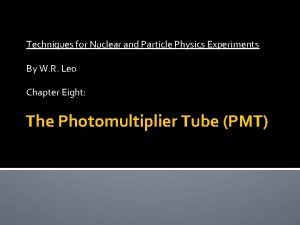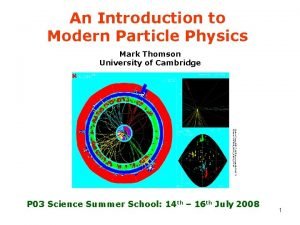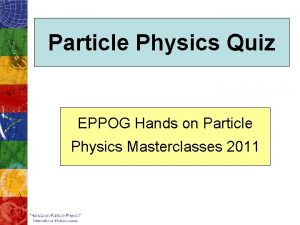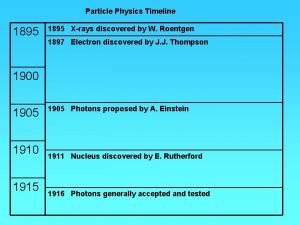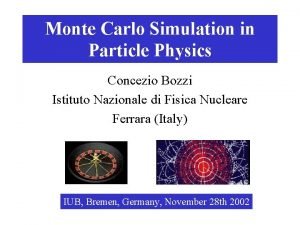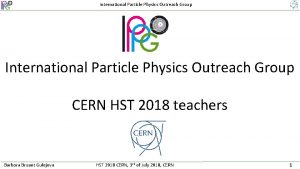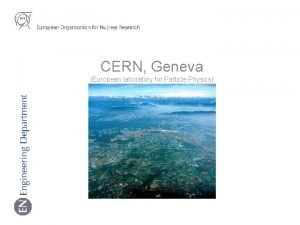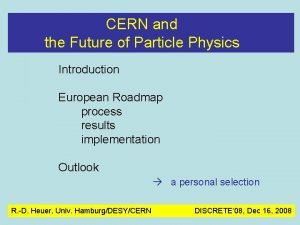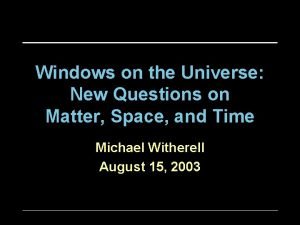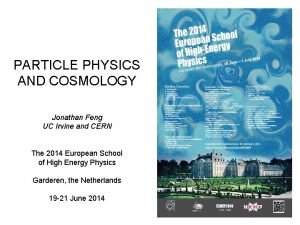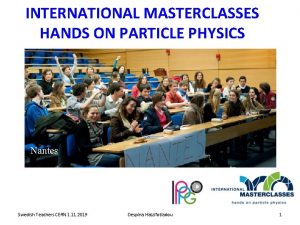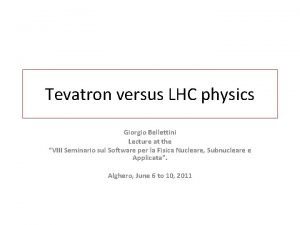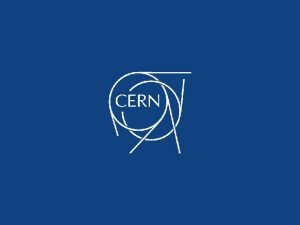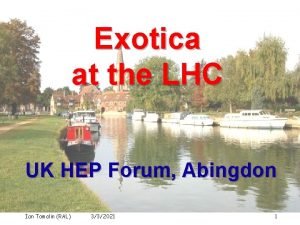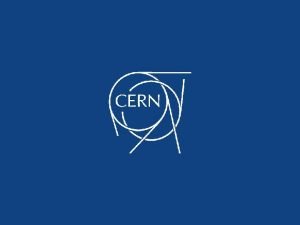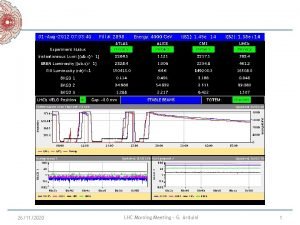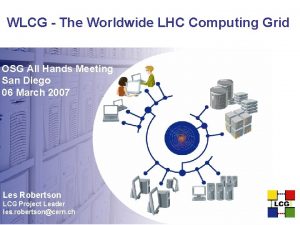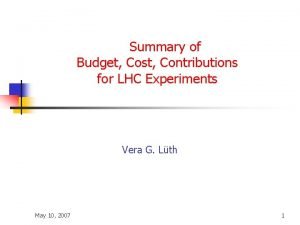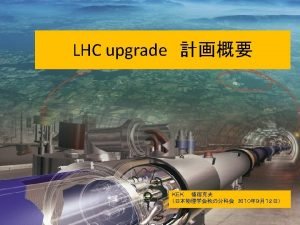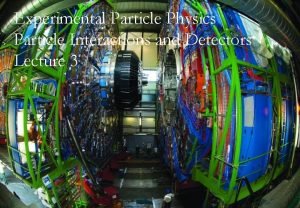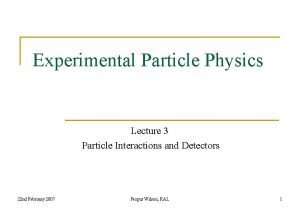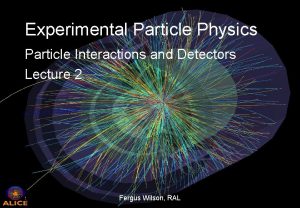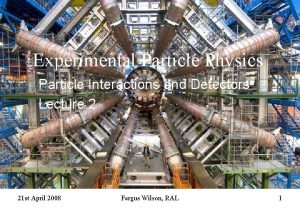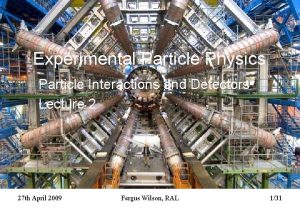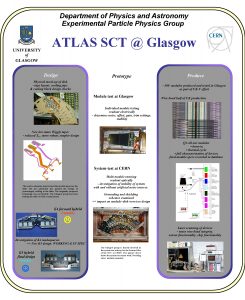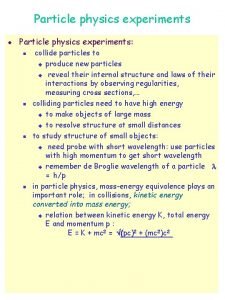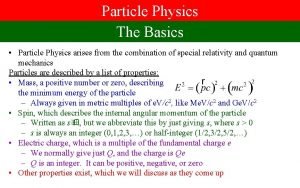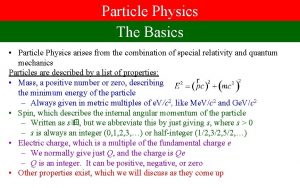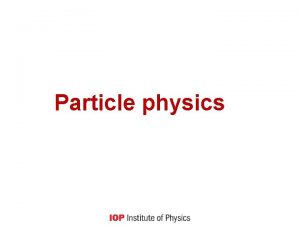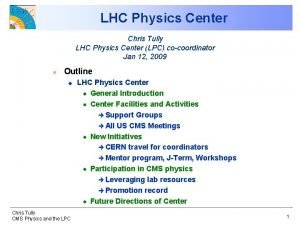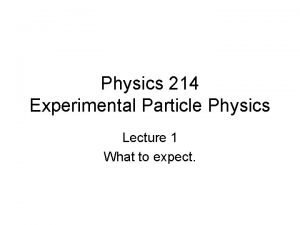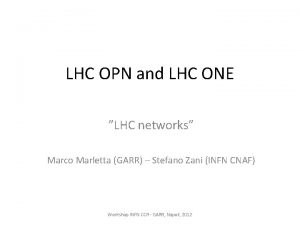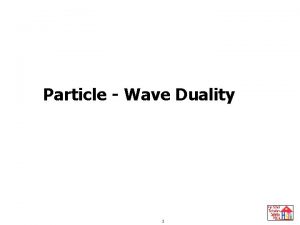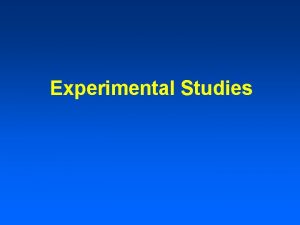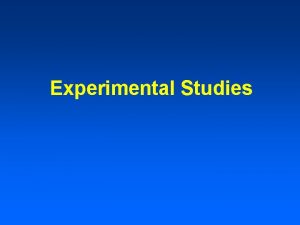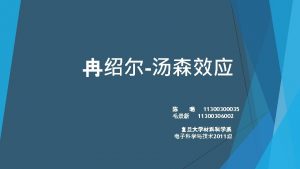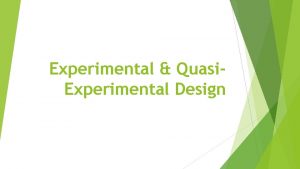Experimental particle physics in the LHC area and




























- Slides: 28

Experimental particle physics in the LHC area and possible implications for development in Africa Kétévi A. Assamagan, Julia Gray, Jacobo Montano, Esmeralda Yitamben

Outline • African institutes in experiments at CERN • Implications for building scientific networks in Africa in particle and nuclear physics – The African school of fundamental physics and its applications • Creating a good resume packet • Applying to graduate schools and postdoctoral positions 08/12/2014 African School of Physics in Dakar Ketevi A. Assamagan, et al 2

Distribution of CERN Users by Nationality ~10, 500 CERN users from all countries. 12 African nations with 72 African participants. CERN has formal agreements or open dialogues with 9 African countries. 08/12/2014 African School of Physics in Dakar Ketevi A. Assamagan, et al 3

CERN Relations with African Nations • Algeria: open talks to join LHC experiments (ATLAS), ISOLDE (University Houari Boumedienne, University of Oran, Center for Development of Advanced Technologies) Egypt: CMS member • • Ghana: digital library techniques, open talks to join ATLAS, CMS (Kwame Nkrumah University of Science and Technology) • Madagascar: open talks to join LHCb (University of Antananarivo) • Morocco: ATLAS member • Mozambique: open talks regarding scientific training (Universidade Eduardo Mondlane) • Rwanda: open talks regarding information technology • South Africa: ALICE, ATLAS, ISOLDE member • Tunisia: previously worked on OPERA. Open talks to join CMS (National Center for Nuclear Sciences and Technologies) 08/12/2014 African School of Physics in Dakar Ketevi A. Assamagan, et al 4

ATLAS Collaboration “South Africa joins the ATLAS experiment The ATLAS collaboration has increased its reach across Africa now that South Africa has joined Morocco as the second member country from that continent. This development follows a unanimous ballot at the meeting of the ATLAS collaboration board in Copenhagen on 2 July [2010]. ” http: //cerncourier. com/cws/article/cern/43506/2 08/12/2014 African School of Physics in Dakar Ketevi A. Assamagan, et al 5

Morocco-ATLAS membership • Thanks to the efforts of a small group of Moroccan academics – Morocco has been participating in the LHC programme since 1996. – 12 Moroccan physicists are members of the ATLAS collaboration • Moroccan physicists network (RUPHE) from different universities in Morocco http: //ruphe. fsac. ma/ – Centre National de l'Energie des Sciences Techniques Nucléaires (CNESTEN), Rabat – Universite Hassan II, Ain Chock, Casablanca – Université Cadi Ayyad, Marrakech – Universite Sidi Med Ben Abdellah, Meknes – Universite Mohammed Premier Oujda, Oujda – Université Mohommed V, Rabat 08/12/2014 African School of Physics in Dakar Ketevi A. Assamagan, et al 6

Morocco-ATLAS • With the support of the Ministry of education and (The National Center for Scientific and Technical Research) CNRST • All these universities are linked thanks to MARWAN (the Moroccan National Research and Education Network) • The Ma. Grid Certificate Authority (At CNRST) provides grid certificates to all Moroccan scientists • 15 Ph. D. students currently working on ATLAS-LHC experiment and CALICE-ILC • 15 theses defended on ATLAS and over 100 international publications • ATLAS week 2013 held in Marrakech, Morocco • Contribution to ATLAS construction: ATLAS Liquid Argon Calorimeter Electronics • Technical studies: luminosity and beam spot determination, inner detector alignment, calibration of triggers • Physics interests: BSM, B-physics, charged Higgs, top quark 08/12/2014 African School of Physics in Dakar Ketevi A. Assamagan, et al 7

South Africa-ATLAS membership • South Africa – University of the Witwatersrand, Johannesburg – University of Johannesburg, Johannesburg – Small groups at starting at • University of Kwazulu-Natal, Durban • University of Cape Town 08/12/2014 African School of Physics in Dakar Ketevi A. Assamagan, et al 8

CMS Collaboration • Over 3000 users working for CMS from institutes 172 institutions in 40 countries, spanning Europe, Asia, the Americas, Australasia and Africa. • Egypt and Tunisia are the only African countries in CMS • There are 22 Africans in CMS Tunisia Egypt 08/12/2014 African School of Physics in Dakar Ketevi A. Assamagan, et al 9

Africa-CMS • Egypt – Academy of Scientific Research and Technology of the Arab Republic of Egypt, Egyptian Network of High Energy Physics, Cairo – Contribution to CMS • Assembly and testing of Muon Resistive Plate Chambers (RPC) • Analysis of beam test data • Tunisia – No current active contribution 08/12/2014 African School of Physics in Dakar Ketevi A. Assamagan, et al 10

ALICE Collaboration 36 Countries including one African country, 132 Institutes 2 of which are from South Africa, and over 1200 members, 5 are Africans 08/12/2014 African School of Physics in Dakar Ketevi A. Assamagan, et al 11

ALICE African Institutes • South Africa, – University of Cape Town (UCT), Cape Town – i. Themba Laboratory, Somerset West • Egypt as an associate member – Academy of Scientific Research and Technology, Cairo 08/12/2014 African School of Physics in Dakar Ketevi A. Assamagan, et al 12

LHCb Collaboration 17 countries, no African country in LHCb 65 institutes, none from Africa 670 members, 1 African Madagascar in open talks to join collaboration 08/12/2014 African School of Physics in Dakar Ketevi A. Assamagan, et al 13

South Africa-ISOLDE • The On-Line Isotope Mass Separator ISOLDE – is a facility dedicated to the production of a large variety of radioactive ion beams – for many different experiments in the fields of nuclear and atomic physics, solid-state physics, materials science and life sciences. – The facility is located at the Proton-Synchrotron Booster (PSB) of CERN. • South African Institutes in ISOLDE – University of Kwazulu – Natal, Durban (KZN) • 1 participant, 1 student – University of the Witwatersrand, Johannesburg • 1 participant, 3 students • Largest group in the collaboration • International collaborators in Denmark, Germany, Italy, Belgium, Iceland 08/12/2014 African School of Physics in Dakar Ketevi A. Assamagan, et al 14

The SA-CERN Program “An important step in developing high-energy physics in South Africa was to unify all of the CERN-based activities into one coherent network, known as the SA-CERN Programme (ATLAS, ALICE, ISOLDE and theory). This networked together on issues of Grid development, student training, schools planning, interaction with government and by applying jointly for support at a national level. ” • These institutes that form the SA-CERN program http: //www. sacern. ac. za – – – i. Themba LABS, Western Cape /Gauteng (ALICE) University of Cape Town, Western Cape (ALICE) University of Johannesburg (ATLAS, Theory) University of the Witwatersrand (ATLAS, ISOLDE, Theory) University of Kwazulu-Natal (ATLAS, ISOLDE) Rhodes University, Eastern Cape (Theory) 08/12/2014 African School of Physics in Dakar Ketevi A. Assamagan, et al 15

The African School of Fundamental Physics and Its Applications http: //www. africanschoolofphysics. org/ Opportunities for networking within and beyond Africa, for graduate and professional opportunities 08/12/2014 African School of Physics in Dakar Ketevi A. Assamagan, et al 16

ASP 2014 • Motivation – – – • Contribute to capacity building in Africa Instill the capacity to harvest, interpret and exploit results from physics experiments Increase proficiency in related applications and technologies Use the LHC and its experiments as an example, although the broader objectives are far beyond We believe that the knowledge that the students gain will benefit them whichever careers they may pursue Student Participation – 328 applications received – 69 students selected – Final participation: 55 students, mainly from Africa, a few from abroad (Iran, USA) • Lectures – – • Theoretical Particle Physics (first week) Experimental Particle Physics (second week) Applications: medical physics, accelerators, technologies (third week) Grid computing, Geant-4 simulation, data analysis Lecturers – A number of excellent lecturers • Financial support – From Africa, Europe, US – universities, laboratories, UN, and other organizations 08/12/2014 African School of Physics in Dakar Ketevi A. Assamagan, et al 17

2010 & 2012 Alumni Survey • 2010+2012 total students: 113 • Survey Respondents: 60 • Respondents from: Nigeria, South Africa, Ghana, Madagascar, Sudan, Kenya, Algeria, Senegal, DRC, Ethiopia, Zambia, Tanzania, Cameroon, Egypt, USA, Iran, Canada 08/12/2014 African School of Physics in Dakar Ketevi A. Assamagan, et al 18

Best Methods of Communication with our Alumni 08/12/2014 African School of Physics in Dakar Ketevi A. Assamagan, et al 19

What do our alumni do? 08/12/2014 African School of Physics in Dakar Ketevi A. Assamagan, et al 20

Where do our alumni go? 08/12/2014 African School of Physics in Dakar Ketevi A. Assamagan, et al 21

When they leave their home country… • Different African country – Move between different geographical regions of north, central, and south • North America – United States: 2 • Asia – China: 2, Malaysia, South Korea, Saudi Arabia • Europe – France: 4, Germany: 2, Belgium, Italy, Turkey 08/12/2014 African School of Physics in Dakar Ketevi A. Assamagan, et al 22

Putting Together a Resume Packet • Cover letter – Format – Themes • Curriculum Vitae – European and American styles – Academic vs. industrial styles • Letters of Recommendation – Choosing your letter writers 08/12/2014 African School of Physics in Dakar Ketevi A. Assamagan, et al 23

Cover Letter • Use formal letter writing style – Your address right-justified – The recipient’s address left-justified – Address letter “Dear [Professional Title] [Last Name]” or “To Whom It May Concern” – Sign with “Sincerely, ” • Highlight strengths from your Curriculum Vitae and tie those attributes to the work being done at the institutes • Include a clear motivation for working at institute, but put emphasis on your practical skills and professional goals 08/12/2014 African School of Physics in Dakar Ketevi A. Assamagan, et al 24

European vs. American European • The ideal size is 2 -3 pages; • The European CV should always be printed on ISO A 4 paper, standard paper size used for different types of business correspondence in most of the world. • It is acceptable, although increasingly optional, to include some personal information on a European CV. - Marital Status - Age - Number of children (ages optional) - Personal Interests - Nationality and gender are also commonly mentioned on a European CV. • Always expected to contain some secondary school information, even if the applicant has an advanced college degree. • In some countries, will contain a professionallooking headshot (photo). American • US resume 1 page; US CV minimum 3 pages; • The U. S. resume and U. S. CV, on the other hand, should always be printed on American “letter size” paper. In the U. S. , “letter size” paper is 8. 5 × 11 inches. • On the other hand, sharing any type of personal information on a resume, CV, or cover letter is considered very unprofessional in the US. • On the other hand, a U. S. CV does not contain this information. • A U. S. resume or U. S. CV will almost never include a photo. Acting resumes and modeling resumes are exceptions.

Academic vs. Industry Academic • Designed for the human eye; • Highlight research or teaching; • Grants and proposals more important; • Describe research with more BASIC approach. Industry • Designed for the human eye and keyword searches; • Always highlight research; • Skills and techniques more important; • Describe research with more APPLIED approach.

Academic vs. Industry Academic • Exhaustive list of publications and presentations; • Include references and contact info; • Initial screening by P. I. or search committee; • Hard copy or email attachment. Industry • Selected publications and presentations (if many); • Send references if requested; • Initial screening by HR or pulled from database; • Submitted online; no hard copy.

Letter of Recommendation: Selecting Writers • Usually need 3 letter writers – For industrial jobs, normally need only to provide contact information of recommenders, no letter required • Choose professional contacts with some standing in field – Either a full professor or adjunct professor • More important to choose writers who know you well than a writer of standing – Choose a professor for whom you have done research or one whose class you’ve done particularly well in 08/12/2014 African School of Physics in Dakar Ketevi A. Assamagan, et al 28
 Hadrons
Hadrons Experimental vs non experimental
Experimental vs non experimental Cross-sectional correlational design
Cross-sectional correlational design Experimental vs non experimental research
Experimental vs non experimental research Experimental vs non experimental
Experimental vs non experimental Nonexperimental study
Nonexperimental study Experimental physics and industrial control system
Experimental physics and industrial control system L
L Experimental physics and industrial control system
Experimental physics and industrial control system Pmt particle physics
Pmt particle physics Mark thomson modern particle physics
Mark thomson modern particle physics Particle physics
Particle physics Particle physics practice quiz
Particle physics practice quiz Particle physics timeline
Particle physics timeline Monte carlo simulation particle physics
Monte carlo simulation particle physics Cern particle physics
Cern particle physics European laboratory for particle physics
European laboratory for particle physics Cern particle physics
Cern particle physics Particle physics
Particle physics Form factor particle physics
Form factor particle physics International masterclasses hands on particle physics
International masterclasses hands on particle physics Bellettini
Bellettini Lhc housing
Lhc housing Hl-lhc schedule
Hl-lhc schedule Hep forum
Hep forum Lhc logbook
Lhc logbook Lhc morning meeting
Lhc morning meeting Worldwide lhc computing grid
Worldwide lhc computing grid Lhc budget
Lhc budget






